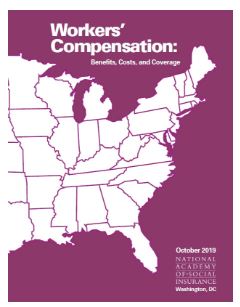|
Workers' Compensation Benefits, Costs, and Coverage (2017 Data)
By: Elaine Weiss, Griffin Murphy, Leslie I. Boden
Published: October 31, 2019

Workers' Compensation Benefits, Costs, and Coverage (2017 Data) provides the only comprehensive data on workers' compensation benefits, coverage, and employer costs for the nation, the states, the District of Columbia, and federal programs.
"This year's report shows that the trends that have dominated the workers' compensation system for the past three decades - declines in both workers' benefits and employers' costs - continue to be sustained," noted Les Boden, Chair of the Academy Study Panel on Workers' Compensation Data and co-author of the report.
"To the extent that costs and benefits have fallen because of improved safety at work, that is, of course, good news. However, there is also evidence that suggests that many injured workers are not receiving the cash benefits and/or medical care they need, and that some states are achieving lower benefits by shifting costs rather than improving safety. We hope policymakers, reporters, researchers, and others continue to delve into these issues and advance policies that help workers and employers delve into these issues and advance policies that help workers and employers achieve a balance that improves outcomes for both," said Boden.
In addition to the full report, including sources and methods, an Executive Summary and four state-specific spotlights on Florida, Missouri, Ohio, and Wyoming are available for download. “The report, together with the companion ‘State Spotlights’ on a few states experiencing unusual trends, shines much-needed light on what is working well and not so well in this critical component of our nation’s social insurance infrastructure,” commented Academy CEO William Arnone.
Highlights:
- Employee coverage has increased fairly steadily over the past few decades, but employer costs have fallen from just over $1.50 per $100 of covered wages in 1997 to $1.25 in 2017.
- Worker benefits decreased even more, from $1.17 twenty years ago to $0.80 per $100 of covered wages in 2017.
- Covered jobs increased in all jurisdictions except Alaska, North Dakota, West Virginia, and Wyoming. Covered wages increased in all jurisdictions except Wyoming.
- Benefits per $100 of covered wages decreased in all jurisdictions except Missouri and Hawaii, where they increased by $0.09 and $0.04, respectively.
- Costs per $100 of covered wages, or standardized costs, decreased in all but five jurisdictions, with the largest percent decrease (38.3 percent) in Oklahoma.
Download the full report.
Read the Executive Summary.
Check out state-specific findings:
*As an Academy Member with expertise in Workers' Compensation, you will soon receive a print copy of the report and other new materials, including the Executive Summary and four State Spotlights.
|
